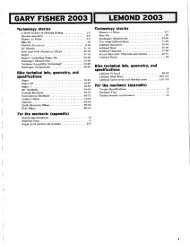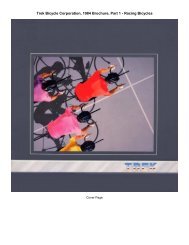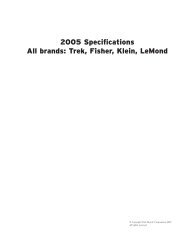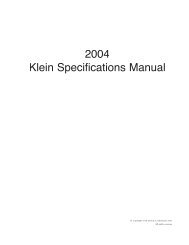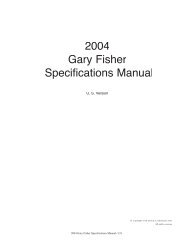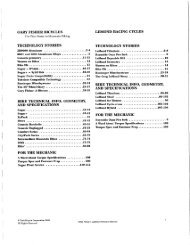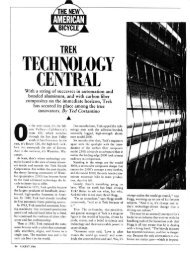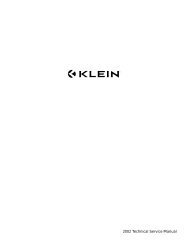TECHNOLOGY STORIES BIKE INFO, GEOMETRY ... - Vintage Trek
TECHNOLOGY STORIES BIKE INFO, GEOMETRY ... - Vintage Trek
TECHNOLOGY STORIES BIKE INFO, GEOMETRY ... - Vintage Trek
Create successful ePaper yourself
Turn your PDF publications into a flip-book with our unique Google optimized e-Paper software.
esult, it is not strong enough to make a good bicycle frame.<br />
By adding various alloying agents to the aluminum,<br />
different characteristics can be obtained. These alloys of<br />
aluminum have a number which describe the alloying elements.<br />
6061 aluminum has small amounts of magnesium,<br />
silicon, copper, and chromium added to the pure aluminum.<br />
This alloy obtains its strength from microscopic precipitates<br />
(magnesium silicide crystals) that mechanically stop the slip<br />
planes in the aluminum crystals from sliding when force is<br />
applied. As an analogy, they work like putting sand in a<br />
sliding bearing.<br />
Aluminum alloys can also be strengthened by mechanical<br />
working. Cold-drawing the tubing is an example of<br />
mechanical working. This causes microscopic defects and<br />
strains in the aluminum crystal, which make it more difficult<br />
for the slip planes to move.<br />
Welding aluminum<br />
When welding 6061, and aluminum alloys in general,<br />
several undesirable things happen.<br />
With changes in temperature, aluminum changes<br />
dimension more than steel. When a weld puddle cools down,<br />
it shrinks and pulls on the adjacent material. With aluminum<br />
alloys this means a weld distorts the material more<br />
and leaves the material under high residual stress after the<br />
weld is complete. This residual stress adversely affects yield<br />
strength and fatigue life.<br />
If the tube had any strengthening due to mechanical<br />
working, this cold-work induced strength would be lost<br />
near the weld where the material was heated to high temperatures.<br />
Welding removes the strengthening effects of the<br />
T6 heat treatment.<br />
The optimum distribution and size of magnesium silicide<br />
crystals are created by the T6 process, which involves a high<br />
temperature solution-quench followed by lower temperature<br />
artificial age. Exposing the material to the high temperatures<br />
of welding dissolves some of these fine crystals and make<br />
others grow large, weakening the material near the weld.<br />
Heat treatment of aluminum<br />
6061 loses so much strength after welding that we<br />
decided there was no alternative but to heat treat the entire<br />
frame after welding in order to obtain a high strength,<br />
long life, lightweight frame. By heat treating the entire<br />
frame to a T6 condition, the material is brought back to<br />
full strength throughout the frame structure. At 1000<br />
degrees in the oven, part of the solution quench process,<br />
the aluminum is close to its melting temperature. All of the<br />
precipitates present at room temperature dissolve into the<br />
aluminum. This makes it so soft that all of the residual weld<br />
stresses are relieved.<br />
Of course we are not the only manufacturers to solution<br />
quench and artificially age the complete frame. Several<br />
other manufacturers of premium frames also typically do<br />
this on frames made of 6061 or other 6000 alloys.<br />
Often the frames made from 7000 alloys are not heat<br />
treated after welding at all. In other cases they are only<br />
artificial aged after welding, which strengthens the material<br />
which was hot enough for long enough to dissolve<br />
the alloying elements, but does nothing for the rest of the<br />
frame material.<br />
<strong>Trek</strong> 2002 Tech Manual<br />
In these cases the alloy just got hot enough to partially<br />
dissolve the alloying elements, or just grow the strengthening<br />
crystals to a large size which weakens the material<br />
substantially. This is called over-aging. It is similar to<br />
what happens if you leave the material in the ageing oven<br />
for too long a time. Some of the crystals grow larger in<br />
size, while others shrink or disappear. The net result is<br />
that the weld is strengthened, but the tubing adjacent to<br />
the weld is weakened. So even though 7000 alloys claim<br />
a higher strength than 6061, it is probably less after welding.<br />
Grain growth<br />
In my opinion, the limiting factor for designing aluminum<br />
frames is the fatigue life. If we design a frame in<br />
6061 T6 for the same fatigue strength as Chrome-Moly, the<br />
6061 frame will have a much higher yield strength than<br />
the steel.<br />
I wanted to make our frames even lighter, so in the<br />
early 80’s I started looking for an aluminum alloy with<br />
a higher fatigue strength. There were a few alloys in the<br />
6000 series that had slightly better test numbers.<br />
The problem with the higher strength alloys is that the<br />
presence of the hardening elements causes the microscopic<br />
aluminum crystals (the grains) to grow when the alloy is<br />
at high temperatures or when it is under stress. Larger<br />
grains result in poor strength properties.<br />
In making a Klein frame, we have multiple steps where<br />
we anneal the material with a high temperature oven cycle,<br />
in order to make it soft so we can perform some type of<br />
butting, swaging, forming or bending operation on it, after<br />
which we have to either solution quench and artificially<br />
age it to bring the strength back prior to the next operation,<br />
or we anneal it again to remove the work hardening<br />
effects of the last operation so we can perform further work<br />
to it.<br />
I took a trip to the Alcoa Research center and talked<br />
to several of their material experts. They told me that<br />
I could not use the higher strength 6000 series alloys I<br />
was interested in because we would see uncontrolled grain<br />
growth in our process. 6061 uses a small amount of<br />
Chromium to help slow down this grain growth. That is<br />
what has made it work well for our early frames. So I did<br />
not find a good replacement for 6061 on the first try.<br />
Developing a recipe for a better aluminum alloy<br />
I am not a metallurgist, so I have worked with several<br />
metallurgists during development , who have helped a<br />
great deal. However, I knew our processes and I knew<br />
what was needed to make a better bike. So I knew what I<br />
was looking for and researched other alloys and their use.<br />
Around 1990, I started looking at some Lithium<br />
Aluminum alloys. These are different than typical aluminum<br />
alloys in that they have significantly lower density,<br />
and increased modulus (that means higher stiffness). They<br />
are not perfect, and have some unique problems to overcome.<br />
The aircraft industry spent millions on their development,<br />
but these alloys have not seen a lot of use to<br />
date.<br />
One of the interesting features of the particular lithium<br />
aluminum alloy I was working with was that it utilized<br />
5





